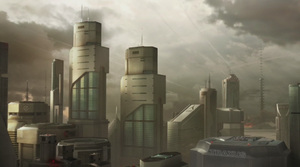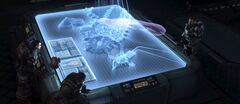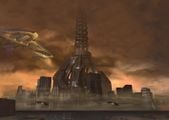New Mombasa
From Halopedia, the Halo wiki

- "This is the only place on Earth the Covenant decided to land. That Prophet is going to tell us why."
- — Admiral Terrence Hood
New Mombasa was a major port city and industrial center on Mombasa Island in the East African Protectorate on Earth. It was the main target of the Covenant attack in the First Battle of Earth.[1] The city was invaded, occupied, and destroyed in the course of the conflict. Near the artificial canal in the city center is the New Mombasa Orbital Elevator, a dominant feature of the city skyline. Old Mombasa is located nearby.
History
Mombasa
Two hundred and fifty years ago New Mombasa—at that time the world's busiest sea port—was chosen to be Earth's first tether city. Over the next eleven years the city experienced explosive growth, but nothing compared to what followed. The city grew out as well as up, its urban sprawl unequaled throughout the continent. By 2430 New Mombasa had absorbed all of the island and many of the surrounding towns found themselves overrun by residents of the old city. The switch was never official and many of the neighborhoods within direct line of sight to the Mombasa Tether still distribute newspapers and chatter directories under their "old" names, but all municipalities within a 74 km radius of the island are now referred to as Old Mombasa.
Mombasa had always been an important port of the Indian Ocean trade routes and was captured and recaptured countless times by a variety of powers including Portugal, the United Kingdom, and various Arab forces. This violent history led to its Swahili nickname "Kisiwa Cha Mvita", or "Island of War". The city became part of the independent nation of Kenya in the 20th century. During this era, Mombasa became a tourist destination, boasting numerous resorts and clean white beaches. It was also important as a port city, connecting East Africa to the Indian Ocean.
Formation of New Mombasa
New Mombasa was the world's busiest sea port in the year 2302, which during that year was chosen to become Earth's first tether city. By 2313, the city had experienced massive growth. New Mombasa's urban sprawl was unequaled throughout Africa.
Mombasa would change dramatically with the arrival of the interstellar era. By 2430, New Mombasa had absorbed the entire island and many of the surrounding towns, which became overrun by residents of Mombasa. The switch of name was never official, and though many of the neighborhoods within direct line of sight to the Mombasa Tether still distributed newspapers and chatter directories under their previous names, all municipalities within a 74 km radius of the island became referred to as "Old Mombasa". The demand for cheap orbital access encouraged the government to construct one of the wonders of the age: a space elevator. This structure served to lift heavy cargo into geosynchronous orbit without expensive booster rockets. The elevator transformed the city; Mombasa became one of the most important port cities on Earth. An influx of trade, citizens, and jobs drastically changed the landscape of the city. Within a century older housing and hotels on Mombasa Island were replaced with vast industrial complexes and gleaming office towers. A large canal cut through the old downtown sector of Sidiriya to provide docking space for incoming cargo ships.
During this period of tremendous growth the city became known as "New Mombasa," with four major sectors: the City Center, Sector A, Sector B, and the Docks. By the 26th century the city was a dynamic, cosmopolitan metropolis, boasting such amenities as a mile-long suspension bridge, a highly efficient MagLev Train system, an automatic highway network, and large-scale recreational areas.
The Covenant Invasion
On October 20th, 2552, a small cluster of Covenant warships exited Slipspace just off of Earth's defensive network. During the ensuing battle, a Covenant Assault Carrier breached the orbital fortifications and made its way to the surface. The ship, which carried the Covenant Hierarch known as the High Prophet of Regret, took position over New Mombasa, deploying troops and vehicles which occupied the city. The city's civilians either evacuated, took shelter, or were killed. In Old Mombasa, announcements in Swahili are broadcast over a public address system. These announcements encourage New Mombasa's citizens to fight against the polytheistic "alien zealots."[2]
The Master Chief arrived in Old Mombasa to help UNSC forces liberate the city from the Covenant. After fighting through the maze-like streets of the mainland, the Master Chief crossed the empty beach below the seawall and then entered the highway system and the bridge to New Mombasa. After a series of quick battles in a public park (the Amphitheater) and the city streets, the Chief boarded and destroyed a Covenant Scarab as it passed through the city's artificial canals. The High Prophet of Regret fled from Earth in his flagship, with the Chief and the In Amber Clad pursuing. The Slipspace rift that the ship opened filled the whole city, but didn't destroy it all, just causing heavy damage to most structures. Although the whole of Mombasa Island was consumed by the Explosion, only the buildings close to the Slip-space vortex were sucked through, though two of its three bridges linking it with the mainland were destroyed.[3] What remains of the city is used by all of the UNSC forces still stationed within the city.
Aftermath
Originally, it was assumed that the slipspace jump of the Prophet of Regret's Assault Carrier had completely obliterated the city, creating the crater seen later in Halo 3. In fact the city, while devastated, still stood long after the ship jumped, and UNSC and Covenant forces clashed for control of the region. It is assumed that the area was later excavated during the Second Battle of Earth, either by Type-47 Ultra Heavy Assault Platform's or by Covenant warships, revealing the Portal to the Ark. Although it was never destroyed.
During the battles for control of the city, an ODST force was inserted to bolster the ground forces already present - the majority were caught in the blast caused by the Assault Carrier's transition. It is unknown exactly how many ODSTs were killed on their way down, though at least six survived landing.[4]
Trivia
- New Mombasa is where turf and tombstone is located.
- Tterrab Industries, a corporation in downtown New Mombasa, is Bungie level designer Chris Barrett's name reversed. "Mtangulizi Kampuni," printed on a welcome mat at the entrance to the building that leads to the canals, is Swahili for "Forerunner Company".[5]
- During the early stages of Halo 2's development, the New Mombasa Orbital Elevator was nowhere to be found. As seen in the Halo 2 E3 Demo, the Space Elevator's site in the heart of the city was occupied by a massive tower shaped like a African Baobab tree surrounded by spires. However, this concept was scrapped and replaced with the Space Elevator in the final version of the game.
Gallery
- Halo3-ODST EnvConcept-08.jpg
Futuristic architecture of New Mombasa.
- Halo3-ODST EnvConcept-10.jpg
Landing pads in the city.
- Halo3-ODST EnvConcept-11.jpg
Reimagined version of the Orbital Elevator for Halo 3:ODST.
- Halo3-ODST EnvConcept-12.jpg
Concept art for the damaged New Mombasa.
- H3ODST NewMombasa02.jpg
Another view of the devastated city.
Sources
- ^ Lord Hood: "This is the only place on Earth the Covenant decided to land. That Prophet is going to tell us why." --Outskirts
- ^ http://nikon.bungie.org/misc/h2dialogue.html?cat=swahili
- ^ Xbox 360 #36 pp34-37
- ^ Halo 3: ODST
- ^ The Internet Living Swahili Dictionary


